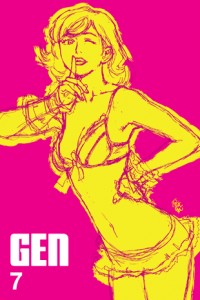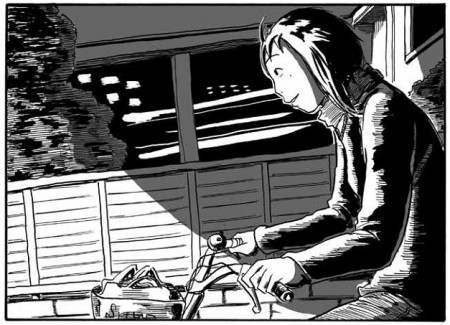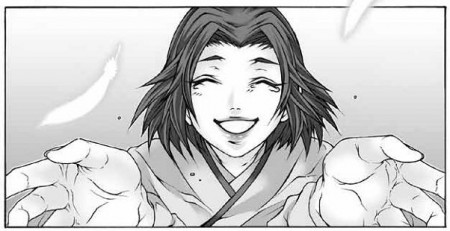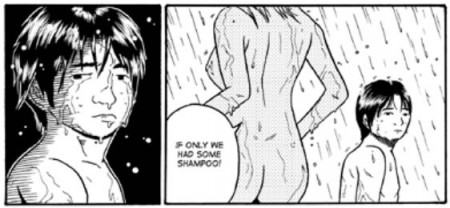Get Gen 7
The seventh issue of GEN Manga continues to evolve from its doujinshi roots into something more like a genuine underground, alternative manga culture anthology that encapsulates upcoming Japanese creators presenting their own unique and personal manga inspired by their own distinct influences. GEN no longer feels like a tentative, experimental project or an attempt to clone Kodansha’s Morning or Afternoon magazines. The periodical now feels like a confident, eclectic primer on varieties of contemporary Japanese manga outside the mainstream of shounen, shoujo, and otaku-centric themes. Fans of conventional manga may find GEN now even more alien while fans of both the manga art form and alternative comics – Japanese or otherwise – may find GEN becoming more rewarding and essential monthly reading.
Nakamura Shige’s boxing serial Wolf continues to largely exclude background art, which focuses attention on the foreground characters but also makes the story lack weight and substance. Brief panels in the seventh chapter which occur in natural environments and include impressionistic backgrounds are appealing and evocative, suggesting how much stronger the manga could possibly be. This chapter introduces a new, interesting plot twist that I haven’t seen in any other boxing manga. The seventh chapter also briefly reintroduces a character who’s been absent for some time, suggesting that Shige has a very conscious and detailed plan for the direction of the narrative. The new plot twist seemingly isn’t used to a great extent, but it is useful in fleshing out protagonist Naoto’s personality, leading up to a chapter conclusion that really reveals a natural maturation in Naoto’s psychology.
The latest chapter of Mihara Gunya’s fantasy serial Kamen introduces some political intrigue and seems to briefly advance the story, but the chapter is once again too short to be very substantial. The visual design in this dialogue-centric chapter requires less dynamic detail than the previous action-filled chapters, so it’s effective although not flashy. Reminiscent of previous chapters, this chapter’s final shot of the castle, rendered with precise, sharp geometry clashes with the rough, sketchy art that characterizes the story. Kamen continues to hint that it has a large and complex universe, but the very short monthly chapters readers are provided only begin to imply the scale and scope of the story and its world, making Kamen just as frustrating as it is rewarding.
The seventh chapter of Souls, continuing the story of Edo era male prostitute Takao, feels largely like a yaoi melodrama. At the same time, this chapter begins to tie threads together, suggesting the possibility of more significant story development to come. Karino Arisa’ art continues to improve. While human faces remain a weakness, proportions aren’t so noticeably wrong in this chapter.
Takayuki Fujimura’s latest chapter of Sorako whimsically illustrates a simple, routine day in protagonist Sorako’s life. The art design and selected focus on particular everyday items gives the chapter a vibrant, almost bohemian energy. The conscious manipulation of making panels progressively bigger evokes a sense of Sorako’s perspective, her life and her sense of freedom expanding from her bedroom to the larger but still constrained workplace, to the freedom that comes after the end of the workday when she’s able to indulge in fancifully pursuing her dream. Although nothing in particular happens in this comic chapter, the story is still engaging and fun, granting viewers a glimpse into the minute of a foreign life.
Hajime Taguchi’s Alive does a masterful job of illustrating the mournful, conflicted teenage sense of alienation and idealism; the sense of not knowing one’s place while harboring a private romanticism that justifies that anxiety. The nameless, hopeless teen protagonist meets a soul mate, a girl in whom he finds companionship and empathy more valuable and engaging than irrepressible adolescent lust. He creates his own Eden, complete with a garden and an angel so beautiful that he fears that his very touch would corrupt her. But this Salinger-esque fantasy cannot withstand the cold, uncompromising insistence of reality, and the story wonderfully reminds readers of that fact ironically before the story becomes too mopish and sentimental. This chapter does include a few panels of non-graphic nudity.
The second chapter of Ryo Hanada’s Good-bye Geist is, honestly, confusing because it develops multiple plot threads simultaneously with no concessions for the reader to keep up. Although the art design resembles shoujo manga, the dialogue is presented in curt, almost abrupt statements that evoke a sense of realism but entirely avoid conventional, and in this case possibly even welcome, exposition. The result is an intriguing manga chapter that challenges readers and seems familiar while being very unusual and unique.
The seventh volume of GEN manga retains Japanese visual sound effects without translations. The absence of translations may be noticeable, but it doesn’t detract from the appreciation of the stories at all. Japanese language signs are translated only when vital to the reader’s understanding of the story. Translation in this issue seems natural and fluid, free of typos and grammatical errors. The layout and monochrome coloring of the PDF pages is crisp and easy to read.
Particularly with the inclusion of “Sorako,” “Alive” and “Good-bye Geist,” GEN Manga increasingly feels like a publication with its own voice and unique value to readers and the American manga publishing community. GEN Manga is a great alternative for readers curious about the scope of manga beyond the mainstream, and a fine primer for alternative comic fans curious about the style and quality of Japanese underground, alternative comics.







